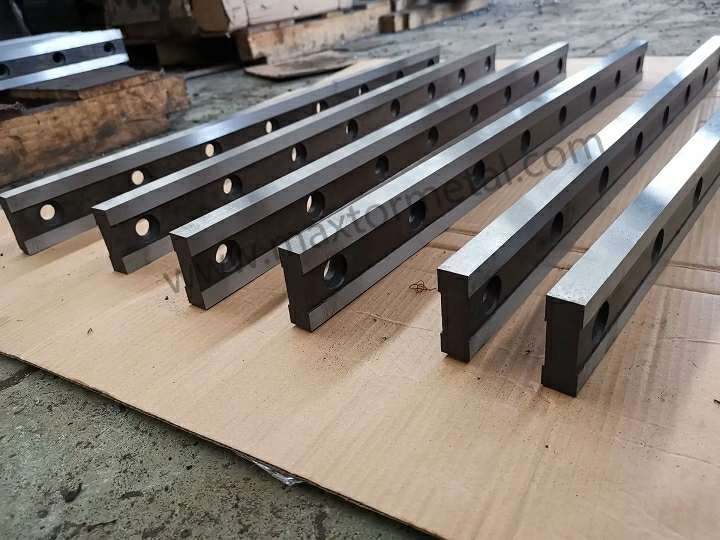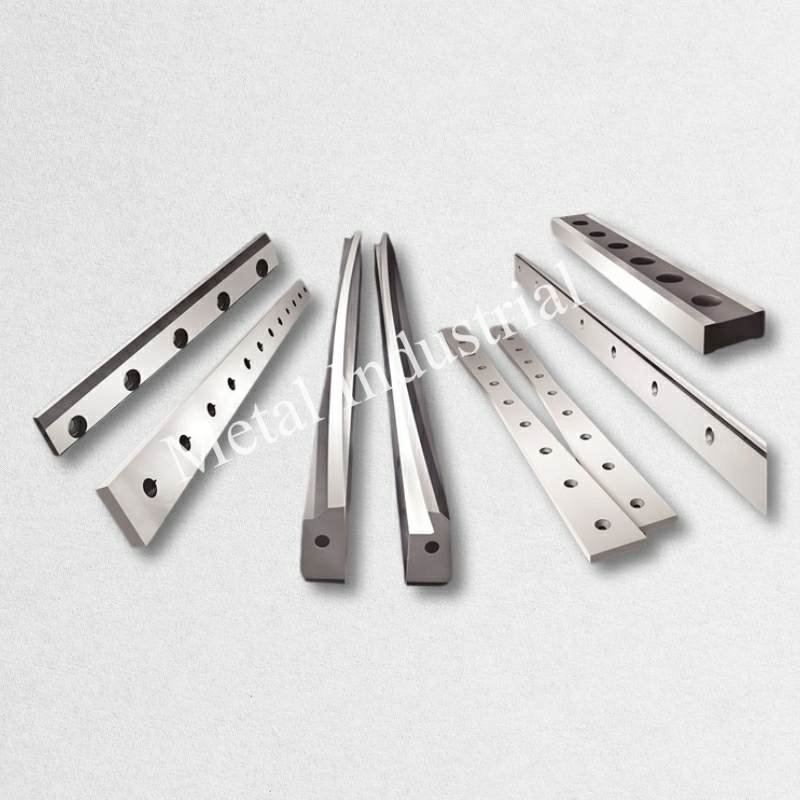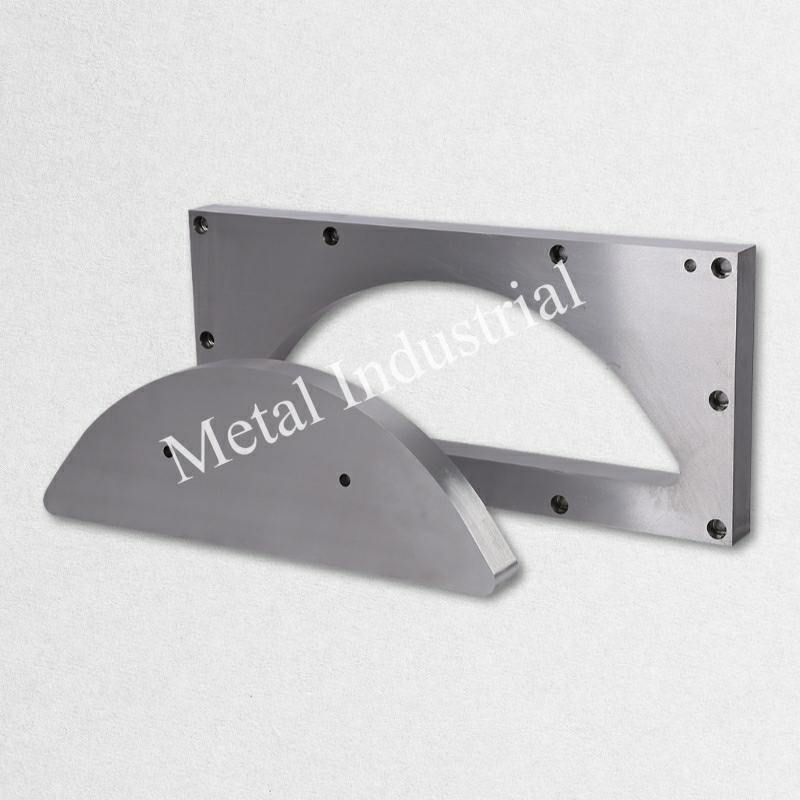Introduction
Shearing machine blades are crucial components in cutting equipment, directly impacting both production efficiency and the quality of finished products. These blades must handle high-intensity cutting tasks while offering wear resistance and shock absorption to extend their lifespan. However, the wide variety of blade materials available can confuse users: which material best meets different cutting needs? How do various materials compare in terms of performance, cost, and durability? This article will provide a professional analysis of the best materials for shearing machine blades, helping you make an informed decision in a complex market.
Overview of Major Shearing Machine Blade Materials
The market offers a wide range of materials for shearing machine blades, each with its own strengths and weaknesses. Understanding the characteristics and applications of these materials will help you better match them to your production needs. Below are some commonly used blade materials and their performance characteristics:
1. Tool Steel
Tool steel is one of the most widely used materials for shearing machine blades, known for its high hardness and excellent wear resistance. This material is typically used in high-strength cutting applications, such as cutting thick plates and hard metals. Elements like tungsten, molybdenum, and vanadium are added to tool steel to enhance its heat resistance, allowing the blade to maintain stable cutting performance even in high-temperature environments. However, tool steel is relatively brittle and prone to breaking under high impact.
2. Alloy Steel
Alloy steel is made by adding various alloying elements, such as chromium, nickel, and vanadium, to improve the steel’s properties. It offers good impact resistance and corrosion resistance, making it suitable for cutting stainless steel, aluminum alloys, and other non-ferrous metals. While alloy steel is slightly less wear-resistant than tool steel, its higher toughness and lower brittleness provide better overall performance in various cutting environments. Additionally, its corrosion resistance in harsh conditions makes it an excellent choice for specific cutting scenarios.
3. Carbon Steel
Carbon steel is one of the most economical blade materials, composed mainly of iron and carbon. Depending on the carbon content, it can be categorized into low, medium, and high carbon steel. Low-carbon steel blades are cost-effective and suitable for cutting materials with low strength, such as standard metal sheets. High-carbon steel, with its higher hardness and wear resistance, can be used for more demanding cutting tasks. However, carbon steel blades are less resistant to corrosion and impact, making them unsuitable for prolonged use in humid or highly corrosive environments.
4. Other Materials
In addition to the three mainstream materials mentioned above, other materials are used for specific applications, such as tungsten carbide and high-speed steel. Tungsten carbide blades, known for their extreme hardness and wear resistance, are ideal for cutting very hard materials but are relatively brittle and expensive. High-speed steel blades maintain high hardness at elevated temperatures, making them suitable for high-speed cutting operations, although their cost is also relatively high and their application scenarios are limited.
Key Factors in Material Selection
When choosing shearing machine blade materials, several key factors must be considered, as they directly affect the blade’s lifespan, cutting quality, and cost-effectiveness. Here are the primary considerations:
1. Type of Material Being Cut
The type of material being cut is the most important factor when selecting blade materials. Different materials require different levels of hardness, toughness, and wear resistance in the blade. For example, steel, aluminum, and copper have varying hardness and ductility, so different blade materials are needed to achieve the best cutting results.
- Steel Cutting: For standard or low-carbon steel plates, high-carbon steel or tool steel blades are the best choices. Their hardness and wear resistance ensure they remain sharp after multiple cuts.
- Stainless Steel Cutting: Due to the high hardness and corrosion resistance of stainless steel, alloy steel blades are often the better choice. They offer a longer lifespan and better cutting surface quality when cutting stainless steel.
- Aluminum Cutting: Aluminum requires blades with good toughness and wear resistance. Alloy steel or high-speed steel blades perform well in this scenario.
2. Cutting Thickness
Cutting thickness directly influences the choice of blade material. For thick plate cutting tasks, the blade needs enough strength and hardness to prevent bending or breaking during the cutting process. For thin plate cutting, the blade must maintain sharpness and wear resistance to avoid creating burrs or irregular edges.
- Thick Plate Cutting: For steel plates over 12mm, tool steel or high-carbon steel blades are recommended. They provide greater cutting force and longer service life.
- Thin Plate Cutting: For aluminum plates under 3mm, alloy steel or high-speed steel blades are ideal, offering smoother cutting surfaces and higher precision.
3. Operating Environment and Frequency
The operating environment and cutting frequency also significantly impact material selection. For shearing machines used frequently, blade material durability and wear resistance are crucial. In humid or highly corrosive environments, corrosion resistance becomes a key consideration.
- High-Frequency Cutting: In high-intensity continuous operations, tool steel and high-speed steel blades are better equipped to handle wear and maintain stable performance over time.
- Harsh Environments: If the work environment has high humidity or acidic substances, the corrosion resistance of alloy steel blades can effectively extend their service life, reducing the need for frequent replacements due to corrosion.
4. Cost-Effectiveness
Blade materials vary significantly in price and lifespan. Choosing the right material involves balancing initial purchase cost with long-term economic efficiency.
- Long-Term Cost: Although tool steel and high-speed steel blades have higher initial costs, their superior durability and cutting performance often reduce replacement frequency, lowering long-term costs.
- Short-Term Budget: If your budget is limited and blade lifespan isn’t a critical concern, carbon steel blades are a more economical choice, suitable for cost-sensitive projects.
Leading Shearing Machine Blade Material Brands
Selecting a reliable brand for blade materials ensures consistent quality. Below are a few leading brands in the market and their characteristics:
1. Böhler Tool Steel
Böhler is a well-known Austrian manufacturer of tool steel, recognized for producing steel that is highly hard and extremely resistant to wear. Their tool steel blades are commonly used for challenging cutting tasks, particularly when cutting through hard steel plates.
2. Uddeholm Alloy Steel
Swedish brand Uddeholm is highly regarded in the alloy steel sector. Their alloy steel blades offer excellent impact resistance and corrosion protection, making them ideal for cutting various metals. Uddeholm blades’ durability makes them a top choice for frequent operations and harsh environments.
3. Hitachi Metals High-Speed Steel
Hitachi Metals’ high-speed steel blades maintain good hardness and sharpness even at high temperatures, making them suitable for high-speed cutting operations. Their products perform exceptionally well in precision cutting, earning favor in the high-end manufacturing industry.
4. ASSAB Carbon Steel
ASSAB is a well-known carbon steel producer. Their carbon steel blades are praised for their cost-effectiveness. For users with a limited budget but still requiring reliable quality, ASSAB carbon steel blades offer an economical solution.
Conclusion and Recommendations
Choosing the right material for shearing machine blades is crucial. Different materials offer various benefits in performance, application scenarios, and cost. Selecting the right material not only extends blade life but also boosts production efficiency and reduces long-term costs. Here are some recommendations:
- High-Strength Cutting: Tool steel blades are recommended for their outstanding hardness and wear resistance, making them suitable for cutting steel and other hard materials.
- Multi-Metal Cutting: Alloy steel blades, with their superior toughness and corrosion resistance, are ideal for cutting stainless steel, aluminum alloys, and other metals.
- Precision Cutting: High-speed steel blades are perfect for high-speed and precision cutting tasks, thanks to their stable performance at high temperatures.
- Budget Cutting: Carbon steel blades are a good choice for budget-conscious users with less demanding durability requirements.
By carefully considering your specific needs and operating environment, you can choose the right blade material to achieve higher efficiency and longer equipment lifespan.
Frequently Asked Questions (FAQ)
1. How do I know when to replace the Shearing Machine Blade?
If the shearing machine blade produces uneven cuts, more burrs, or requires significantly more cutting force, it likely needs replacing. Regularly checking the blade’s sharpness and wear can help you identify problems early, preventing disruptions in production.
2. How long do blades made from different materials last?
The lifespan of a blade depends on its material’s hardness, wear resistance, and the operating environment. Generally, tool steel and high-speed steel blades have longer lifespans, especially in high-strength cutting tasks. Carbon steel blades, with lower hardness, are better suited for short-term or low-intensity cutting tasks.
3. Can I mix blades made from different materials?
It’s advisable to avoid mixing blades of different materials. Different materials have varying hardness levels, wear rates, and cutting effects, which could lead to uneven blade wear and compromised cutting quality.
Shearing Machine Blade Solutions
Nanjing Metal Industrial CO., Limited has extensive industry experience and professional knowledge to provide the most suitable blade solutions for your shearing machine needs. We understand that every customer’s requirements are unique, so we offer both standard products and customized solutions tailored to your specific needs. By choosing the right blade material, you can enhance productivity, extend equipment lifespan, and achieve a higher return on investment.
If you have any questions about selecting the right shearing machine blade material, feel free to contact us. Our expert team is ready to provide you with professional advice to help you make the best choice. You can also visit our website for more information and to schedule a free consultation.
Conclusion
This article aims to help shearing machine users navigate the complex market by providing in-depth material analysis and application scenario interpretations. Making the right material choice can boost production efficiency, reduce maintenance costs, and extend blade life. We hope this guide helps you clearly understand the key considerations when selecting shearing machine blade materials, enabling you to make more informed purchasing decisions.









2 Responses
I’m really impressed together with your writing talents as well as with the layout on your weblog.
Anyway keep up the nice quality writing, it’s rare to see
a great weblog like this one nowadays.
Yes,thank you.